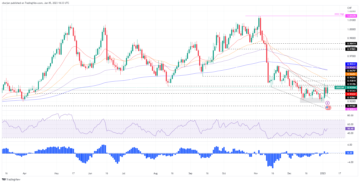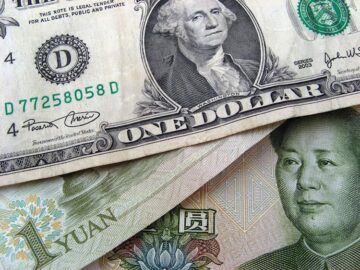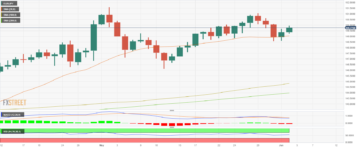
- DXY Index witnesses minor incline, hitting an early November peak at 106.30.
- US housing data reveals weakness with Building Permits and Housing Starts falling.
- Powell commented that the monetary policy need “some additional time to work”.
The US Dollar Index (DXY) is trading at 106.30 with gains on Tuesday, and the DXY continues to benefit from robust Retail Sales data revealed on Monday. Weak housing data didn’t trigger any reaction from the USD.
The US economy is witnessing robust growth and persistent inflation. Meanwhile, the Federal Reserve (Fed) sends mixed signals: that it’s not keen on rate increases but welcomes market-led tightening via higher yields. Following the report of strong March inflation and labor data, easing expectations for June and July have plummeted, which fueled the USD’s rally.
Daily digest market movers: DXY holds strong despite weak housing data, hawkish Powell
- March’s Building Permits recorded a decline of 4.3%, descending to 1.458 million, beneath both the projected 1.514 million and February’s 1.523 million.
- Housing Starts witnessed a notable descent of 14.7%, collapsing from 1.549 million to 1.321 million, not reaching the expected total of 1.48 million.
- Industrial Production for March rose by 0.4% MoM, matching expectations.stments on their expectations, basically confirming that it may be appropriate to delay the easing cycle.
- After the recent inflow of robust US data, market participants are adjusting their easing anticipations. At present, the market anticipates the initial rate cut to materialize in September with a 70% probability for a second cut in December.
- The investor’s expectations of a June rate cut have diminished to 25% against 60% the previous week.
DXY technical analysis: DXY continues gaining ground, bulls might eventually take breather
The indicators on the daily chart reflect a bullish scenario for the DXY. The Relative Strength Index (RSI) is showing overbought conditions, typically indicating strong upward momentum. Similarly, the Moving Average Convergence Divergence (MACD) has rising green bars, showing a positive momentum in favor of bulls. However, the rally might have become overextended as these indicators flash overbought signals and might correct in the next sessions.
In addition to this, the currency index is trading above all its Simple Moving Averages (SMAs) at 20, 100 and 200 days. The SMAs suggest a long-term bullish trend. Together, these indicators show that buying momentum is dominant over selling momentum.
Central banks FAQs
Central Banks have a key mandate which is making sure that there is price stability in a country or region. Economies are constantly facing inflation or deflation when prices for certain goods and services are fluctuating. Constant rising prices for the same goods means inflation, constant lowered prices for the same goods means deflation. It is the task of the central bank to keep the demand in line by tweaking its policy rate. For the biggest central banks like the US Federal Reserve (Fed), the European Central Bank (ECB) or the Bank of England (BoE), the mandate is to keep inflation close to 2%.
A central bank has one important tool at its disposal to get inflation higher or lower, and that is by tweaking its benchmark policy rate, commonly known as interest rate. On pre-communicated moments, the central bank will issue a statement with its policy rate and provide additional reasoning on why it is either remaining or changing (cutting or hiking) it. Local banks will adjust their savings and lending rates accordingly, which in turn will make it either harder or easier for people to earn on their savings or for companies to take out loans and make investments in their businesses. When the central bank hikes interest rates substantially, this is called monetary tightening. When it is cutting its benchmark rate, it is called monetary easing.
A central bank is often politically independent. Members of the central bank policy board are passing through a series of panels and hearings before being appointed to a policy board seat. Each member in that board often has a certain conviction on how the central bank should control inflation and the subsequent monetary policy. Members that want a very loose monetary policy, with low rates and cheap lending, to boost the economy substantially while being content to see inflation slightly above 2%, are called ‘doves’. Members that rather want to see higher rates to reward savings and want to keep a lit on inflation at all time are called ‘hawks’ and will not rest until inflation is at or just below 2%.
Normally, there is a chairman or president who leads each meeting, needs to create a consensus between the hawks or doves and has his or her final say when it would come down to a vote split to avoid a 50-50 tie on whether the current policy should be adjusted. The chairman will deliver speeches which often can be followed live, where the current monetary stance and outlook is being communicated. A central bank will try to push forward its monetary policy without triggering violent swings in rates, equities, or its currency. All members of the central bank will channel their stance toward the markets in advance of a policy meeting event. A few days before a policy meeting takes place until the new policy has been communicated, members are forbidden to talk publicly. This is called the blackout period.
- SEO Powered Content & PR Distribution. Get Amplified Today.
- PlatoData.Network Vertical Generative Ai. Empower Yourself. Access Here.
- PlatoAiStream. Web3 Intelligence. Knowledge Amplified. Access Here.
- PlatoESG. Carbon, CleanTech, Energy, Environment, Solar, Waste Management. Access Here.
- PlatoHealth. Biotech and Clinical Trials Intelligence. Access Here.
- Source: https://www.fxstreet.com/news/us-dollar-holds-gains-despite-weak-housing-data-202404161615
- :has
- :is
- :not
- :where
- 1
- 100
- 11
- 14
- 2%
- 20
- 200
- 24
- 30
- 321
- 4
- 48
- 8
- a
- above
- accordingly
- addition
- Additional
- adjust
- Adjusted
- adjusting
- advance
- against
- All
- an
- analysis
- and
- anticipates
- any
- appointed
- appropriate
- ARE
- AS
- At
- average
- avoid
- Bank
- Bank of England
- Bank of England (BOE)
- Banks
- bars
- Basically
- BE
- become
- been
- before
- being
- below
- Benchmark
- Benchmark Rate
- benefit
- between
- Biggest
- board
- BoE
- boost
- both
- Building
- Bullish
- Bulls
- businesses
- but
- Buying
- by
- called
- CAN
- central
- Central Bank
- Central Banks
- certain
- chairman
- changing
- Channel
- cheap
- checked
- Close
- come
- commented
- commonly
- communicated
- Companies
- conditions
- confirming
- Consensus
- constant
- constantly
- content
- continues
- control
- control inflation
- Convergence
- conviction
- correct
- country
- create
- Currency
- Current
- Cut
- cuts
- cutting
- cycle
- daily
- data
- Days
- December
- Decline
- deflation
- delay
- deliver
- Demand
- Despite
- Digest
- disposal
- Divergence
- Dollar
- dollar index
- dominant
- down
- Dxy
- each
- Early
- earn
- easier
- easing
- ECB
- economies
- economy
- either
- England
- Equities
- European
- European Central Bank
- Event
- eventually
- expectations
- expected
- facing
- Falling
- FAQ
- favor
- February
- Fed
- Federal
- federal reserve
- few
- final
- Flash
- followed
- following
- For
- forex
- Forward
- from
- fueled
- gaining
- Gains
- get
- goods
- Green
- Ground
- Growth
- harder
- Have
- Hawkish
- her
- higher
- Hikes
- hiking
- his
- hitting
- holds
- housing
- How
- However
- HTTPS
- important
- in
- Increases
- independent
- index
- indicating
- Indicators
- inflation
- initial
- interest
- INTEREST RATE
- Interest Rates
- Investments
- issue
- IT
- ITS
- jpg
- July
- june
- just
- Keen
- Keep
- Key
- known
- labor
- Leads
- lending
- like
- Line
- live
- Loans
- local
- LOCAL BANKS
- long-term
- Low
- low rates
- lower
- lowered
- MACD
- make
- Making
- mandate
- March
- Market
- Markets
- matching
- materialize
- May..
- means
- Meanwhile
- meeting
- member
- Members
- might
- million
- minor
- mixed
- mom
- Moments
- Momentum
- Monday
- Monetary
- Monetary Policy
- monetary tightening
- Movers
- moving
- moving average
- moving averages
- Need
- needs
- New
- new policy
- next
- notable
- November
- of
- often
- on
- ONE
- or
- out
- Outlook
- over
- panels
- participants
- Passing
- Peak
- People
- period
- permits
- Place
- plato
- Plato Data Intelligence
- PlatoData
- policy
- politically
- positive
- Powell
- present
- president
- previous
- price
- Prices
- probability
- Production
- projected
- provide
- publicly
- Push
- rally
- Rate
- Rates
- rather
- reaching
- reaction
- reasoning
- recent
- recorded
- reflect
- region
- relative
- relative strength index
- Relative Strength Index (RSI)
- remaining
- report
- Reserve
- REST
- Revealed
- Reveals
- Reward
- rising
- robust
- ROSE
- rsi
- s
- same
- Savings
- say
- scenario
- Second
- see
- Selling
- sends
- September
- Series
- Services
- sessions
- should
- show
- showing
- signals
- Similarly
- Simple
- slightly
- SMAs
- some
- speeches
- split
- Stability
- stance
- starts
- Statement
- strength
- Strengthens
- strong
- subsequent
- substantially
- suggest
- sure
- Swings
- Take
- takes
- Talk
- Task
- Technical
- Technical Analysis
- that
- The
- The US Federal Reserve
- their
- There.
- These
- this
- Through
- TIE
- tightening
- time
- to
- together
- tool
- Total
- toward
- Trading
- Trend
- trigger
- triggering
- try
- Tuesday
- TURN
- tweaking
- typically
- until
- upward
- upward momentum
- us
- US Dollar
- US Dollar Index
- US economy
- US Federal
- us federal reserve
- USD
- v1
- very
- via
- Vote
- want
- weakness
- week
- Welcomes
- when
- whether
- which
- while
- WHO
- why
- will
- with
- without
- witnessed
- witnessing
- Work
- would
- yields
- zephyrnet










